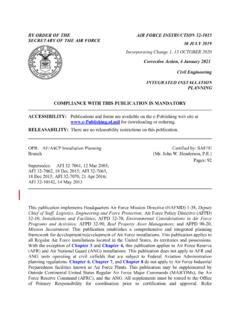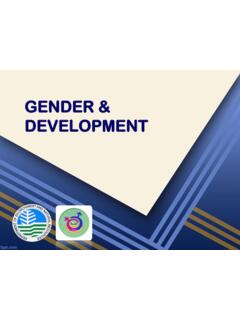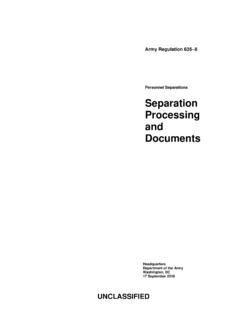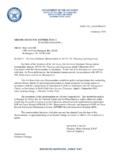Transcription of of Subdisciplines Army Information Technology ...
1 UNCLASSIFIED Department of the Army Pamphlet 25 1 1 Information Management: Management of Subdisciplines Army Information Technology Implementation Instructions Headquarters Department of the Army Washington, DC 15 July 2019 SUMMARY of CHANGE DA PAM 25 1 1 Army Information Technology Implementation Instructions This major revision, dated 15 July 2019 o Updates governance forums to include the Information Technology Oversight Council (table 2 1). o Updates guidance contained in DODI (table 2 2). o Establishes the requirement to obtain a Statement of Non-Availability for Information Technology procurements outside the Computer Hardware, Enterprise Software and Solutions process (para 2 6c(2)). o Updates the Information Technology systems acquisition and delivery systems procurement strategies and procurement contracting organizations and removes references to legacy contracting organizations and centers (para 2 8).
2 O Updates Army guidance related to the redistribution and disposal of Information Technology assets to incorporate policies contained in cybersecurity regulations and pamphlets regarding the reuse of Army computer hard drives and sanitization of media (para 2 9). o Introduces the Department of Defense Information network and Department of Defense Information network Army terminology, processes, and services and replaces the previous legacy Global Information Grid references, terms, and processes (para 2 11). o Replaces the legacy Global Information Grid waiver process with the new Department of Defense temporary exception to policy process for requesting connection exceptions for non-Defense Information System Network connections (para 2 26). o Incorporates and updates previous content into new chapter 5 (formerly chap 3). o Realigns, updates, and consolidates processes and procedures into new chapter 3 (formerly chap 5).
3 O Removes previous content about telecommunications and unified capabilities and refers all Army users to follow the policies, procedures, and guidance provided AR 25 13 (formerly chap 7). o Updates telework program instructions (app B). o Provides a new Army standard for life cycle replacement of Information Technology assets (app H). o Incorporates detailed governance and network implementation guidance, processes, and procedures previously contained in AR 25 1 to this pamphlet and other Army regulations and pamphlets, as cited (throughout). o Incorporates Army Directive 2016 18, Divesting Legacy Information Technology Hardware, Software, and Services in Support of the Army Network (throughout). *This publication supersedes DA Pam 25 1-1 dated 26 September 2014. DA PAM 25 1 1 15 July 2019 UNCLASSIFIED i Headquarters Department of the Army Washington, DC *Department of the Army Pamphlet 25 1 1 15 July 2019 Information Management : Management of Subdisciplines Army Information Technology Implementation Instructions History.
4 This publication is a major revi-sion. Summary. This pamphlet provides pro-cedures for acquiring and managing infor - mation Technology support and services and applies to Information Technology devel-oped for or purchased by the Department of the Army. It establishes procedures for the administration of Information resources and the supporting Technology requirements. This pamphlet supports AR 25 1 in imple-menting Public Law 104 106 and Section 2223, Title 10, United States Code. Chief Information officer functions and those of corresponding Information management and/or Information Technology official and management processes are delineated in this pamphlet. These management pro-cesses involve strategic planning , business process analysis and improvement, capital planning and investment control, and infor - mation Technology performance measure-ments.
5 Applicability. This pamphlet applies to the Regular Army, the Army National Guard/Army National Guard of the United States, and the Army Reserve, unless otherwise stated. It also applies to the infor - mation Technology at all Army installations, activities, and communities. This pamphlet applies to platform Information technol-ogy/industrial control systems; appropri-ated-funded morale, welfare, and recreation support systems; nonappropriated fund mo-rale, welfare, and recreation support sys-tems; and contractor-owned, contractor op-erated systems operated on behalf of the Army. During mobilization, this publica-tion can be modified to support policy changes as necessary. Proponent and exception authority. The proponent of this publication is the Chief Information Officer/G 6. The propo-nent has the authority to approve exceptions or waivers to this pamphlet that are con-sistent with controlling law and regulations.
6 The proponent may delegate this approval authority, in writing, to a division chief within the proponent agency, its direct re-porting unit, or field operating agency, in the grade of colonel or the civilian equiva-lent. Activities may request a waiver to this publication by providing justification that includes a full analysis of the expected ben-efits and must include formal review by the activity s senior legal officer. All waiver re-quests will be endorsed by the commander or senior leader of the requesting activity and forwarded through their higher head-quarters to the policy proponent. Refer to AR 25 30 for specific guidance. Suggested improvements. Users are invited to send comments and suggested improvements on DA Form 2028 (Recom-mended Changes to Publications and Blank Forms) directly to the Chief Information Officer/G 6 (SAIS PRG), 107 Army Pen-tagon, Washington, DC 20310 0107.
7 Distribution. This pamphlet is available in electronic media only and is intended for the Regular Army, the Army National Guard/Army National Guard of the United States, and the Army (Listed by paragraph and page number) Chapter 1 Introduction, page 1 Purpose 1 1, page 1 References and forms 1 2, page 1 Explanation of abbreviations and terms 1 3, page 1 Exceptions 1 4, page 1 Overview 1 5, page 1 Pamphlet structure 1 6, page 2 Chapter 2 Information Technology Investment Management, page 2 Section I planning , page 2 Contents Continued ii DA PAM 25 1 1 15 July 2019 Governance forums 2 1, page 2 Information Technology planning 2 2, page 4 planning , programming, budgeting, and execution for Information Technology requirements and capabilities 2 3, page 6 Information Technology resource management 2 4, page 8 Section II Control, page 8 Army Portfolio Management Solution 2 5, page 8 Procurement of Information Technology requirements 2 6, page 9 Management and accountability of internal use software 2 7, page 11 Army Information Technology service management 2 8.
8 Page 11 Information Technology systems acquisition and delivery strategies 2 9, page 13 Redistribution and disposal of Information Technology assets 2 10, page 18 Use of government purchase cards for purchase of Information Technology assets 2 11, page 19 Joint capabilities 2 12, page 20 Section III Implementation and Fielding, page 21 Army interoperability certification and baseline configuration management 2 13, page 21 Information support plan process 2 14, page 25 Managing Information Technology at the installation 2 15, page 27 Network Enterprise Center 2 16, page 28 Senior Information management office/officer concept and functions 2 17, page 28 Information management office/officer concept and functions 2 18, page 28 Information transmission economy and systems discipline 2 19, page 30 Information Technology support for telework or telecommuting 2 20, page 31 Training 2 21, page 33 Information processing services 2 22, page 34 Technical documentation 2 23, page 34 Electronic document management 2 24, page 35 Electronic signatures 2 25, page 36 Non-Department of Defense Information network connection exceptions 2 26, page 37 Self-service printing device management procedures 2 27, page 37 Information Technology management career program 34 2 28, page 38 Performance-based strategic management 2 29, page 39 Chapter 3 Enterprise Architecture, page 44 Army Information Enterprise Architecture development 3 1, page 44 Components of the Army Information Enterprise Architecture 3 2, page 44 Information Enterprise Architecture overview 3 3, page 45 Information Enterprise Architecture governance 3 4, page 48 Chapter 4 Data Management, page 48 Army data strategy 4 1, page 49 Army data management program 4 2, page 50 Army data governance 4 3.
9 Page 55 Chapter 5 Information Technology Solutions Implementation, page 56 Section I Network Capacity, page 56 Information Technology requirements in military construction projects 5 1, page 56 Energy management of Information Technology equipment 5 2, page 58 Contents Continued DA PAM 25 1 1 15 July 2019 iii Army data center consolidation 5 3, page 58 Network systems 5 4, page 60 Telecommunication systems and unified capabilities 5 5, page 63 Section II User Facing Services, page 63 Federal law, regulation, and policy compliance 5 6, page 63 Content propriety and quality 5 7, page 66 Usability criteria 5 8, page 67 Consistent and nonredundant Information 5 9, page 68 Training and compliance 5 10, page 69 Website planning and sponsorship 5 11, page 69 Army website domain name exceptions 5 12, page 71 Internet-based capabilities 5 13, page 72 Public Army internet service on an unclassified network 5 14, page 74 Private Army internet services process 5 15, page 78 Support for health, morale, and welfare or morale, welfare, and recreation telecommunications 5 16, page 78 Network Enterprise Center website administration 5 17, page 79 Collaboration capabilities 5 18, page 80 Army Centralized Army Service Request System 5 19, page 81 Section III Privacy Impact Assessments/Electromagnetic Spectrum Operations, page 82 Privacy impact assessment process 5 20, page 82 Electromagnetic spectrum operations 5 21, page 83 Appendixes A.
10 References, page 85 B. Instructions on Telework Program, page 94 C. Funding, Billing, and Accounting for Information Resources, page 98 D. Element of Resource Codes, page 102 E. Army Capabilities and Architecture Development and Integration Environment, page 103 F. Administrative Request Memorandum for Print Devices, page 105 G. Army Portfolio Management Solution Registration Business Rules, page 106 H. Army Standard for Life Cycle Replacement of Information Technology Assets, page 109 Table List Table 2 1: Chief Information Officer/G 6 governance forums, page 3 Table 2 2: Army Enterprise Service Management Framework life cycle description, page 12 Table 2 3: Clinger-Cohen Act compliance example, page 14 Table 2 4: Army required Information support plan Department of Defense Architectural Framework views, page 26 Table 3 1: Consumers of Information Enterprise Architecture products and anticipated product use, page 47 Table 4 1: Army Data strategic Goals and Enabling Objectives, page 50 Table 4 2: Department of Defense level issuances with unique identification/identifier guidance, page 53 Table H 1: Hardware and mission unique equipment life cycle replacement categories, page 109 Figure List Figure 2 1: Chief Information officer Clinger-Cohen Act authority, page 14 Figure 2 2.
















